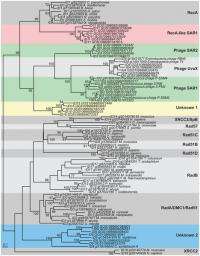March 30, 2011 report
More possible branches to the domain of life

(PhysOrg.com) -- When it comes to the current domain of life, we are familiar with the three branches: bacteria, archaea, and eukaryotes. However, Jonathan Eisen of UC Davis and his team have published possible evidence in PLOS One that shows the possibility of a fourth branch.
The domain of life has changed quite a bit over the years. Until the 1990s, there were only two branches, eukaryotes and one for everything else. That second branch was then broken down into the bacteria and archaea branches.
Utilizing a technique called metagenomics, Eisen and his team were able to sequence a series of samples taken from a collection of seawater taken during the Global Ocean Sampling Expedition. They found a sampling of sequences that belonged to superfamilies of genes known as recA and rpoB. However, these samplings were unlike any that have been seen before.
Eisen and his team are unsure what organism these genes could belong too. Two possibilities being addressed are that of a very unusual and new virus, or the possibility of a fourth branch in the domain of life.
There is debate about the possibility of a fourth domain and where these sequences came from. Radhey Gupta from McMaster University suggests that the sequences could be from cellular organisms living in an environment that caused rapid evolution and that the addition of a fourth domain could just add confusion.
Further study of the samples will be conducted to determine if these two new gene families have rapidly evolved or if they come from a cellular organism with a strange genome.
This is not the first time talk of a fourth domain has been approached. Many believe the mimivirus could represent a fourth domain. As the largest known virus, the mimivirus, while seen as a virus, also shows many genes only found in cellular organisms.
Should the mimivirus be determined to be a fourth branch, then the new sequences discovered by Eisen and his team could represent a fifth branch. It appears as if the possibility of our domain of life growing a bit bigger with new branches could be in the future.
More information: Wu D, Wu M, Halpern A, Rusch DB, Yooseph S, et al. (2011) Stalking the Fourth Domain in Metagenomic Data: Searching for, Discovering, and Interpreting Novel, Deep Branches in Marker Gene Phylogenetic Trees. PLoS ONE 6(3): e18011. doi:10.1371/journal.pone.0018011
© 2010 PhysOrg.com



















